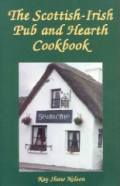-
History of:
- Resources about:
- More:
- Baby walkers
- Bakehouses
- Bed warmers
- Beer, ale mullers
- Besoms, broom-making
- Box, cabinet, and press beds
- Butter crocks, coolers
- Candle snuffers, tallow
- Clothes horses, airers
- Cooking on a peat fire
- Drying grounds
- Enamel cookware
- Fireplaces
- Irons for frills & ruffles
- Knitting sheaths, belts
- Laundry starch
- Log cabin beds
- Lye and chamber-lye
- Mangles
- Marseilles quilts
- Medieval beds
- Rag rugs
- Rushlights, dips & nips
- Straw mattresses
- Sugar cutters - nips & tongs
- Tablecloths
- Tinderboxes
- Washing bats and beetles
- Washing dollies
- List of all articles
Subscribe to RSS feed or get email updates.
The various sorts of peat vary exceedingly in their value as a fuel. The flaw [surface] peat affords but a very weak fire, burns rapidly away, like a parcel of dry sticks or straws, and leaves as few ashes behind.. The heather peat, and the spongy brown peat, formed by the decay of herbaceous plants, are somewhat better, being a little more lasting. But the solid black peat, formed from wood, and which lies deep, is much preferable to these, and makes the best fuel. The mosses in which birch timber prevails, afford a peat more inflammable than those which only contain oak...
Prize Essays and Transactions of the Highland Society of Scotland, 1803
Many years ago, as doubtless some of our oldest citizens will recollect, peat, in its crude, unmanufactured state, was sold in Boston in considerable quantities. It is extensively used in many places in New England...and I have heard of those who have laid in considerable quantities of it in Newton, Heading, Lynn, and in numerous places on the Cape.
Thomas Hooker Leavitt, Facts about Peat as an Article of Fuel, 1865
Kay Shaw Nelson, The Scottish-Irish Pub and Hearth Cookbook: Recipes and Lore from Celtic Kitchens
from Amazon.comor Amazon UK

The smoke of peat being exceedingly acrid and disagreeable, it is in some countries charred before it is used as fuel. The Dutch, who use a great deal of peat, char what they put into the pans with which they keep their feet warm at home and at church. It is first burned in the kitchen, and when it is red hot, they take it off the fire, and stifle it in an earthen pot by covering it up with a wet cloth. This charred peat they also use for cooking...
Webster and Parkes, An Encyclopædia of Domestic Economy, 1855
From 24 to 30 cart-loads of peat [per year] is considered sufficient for a cottager's family, having only one constant fire. Where peats are used as fuel, it is a prudent precaution in a rainy climate, to have peats sufficient for the consumption of two years. Peats a year old are much freer [burn better], and the quality is in every other respect superior.
General report of the agricultural state...of Scotland, 1814
Turf fires - burning peat
Cooking and living with peat fires
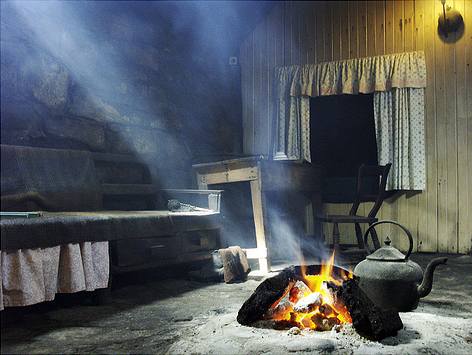 Peat fires may seem like a wintertime topic, but in fact summer is the time
for cutting turves of peat, drying them, and stacking them.
Peat fires may seem like a wintertime topic, but in fact summer is the time
for cutting turves of peat, drying them, and stacking them.
There used to be many areas of northern Europe better supplied with peat bogs than with trees. Peat, also called turf, was a convenient household fuel when there wasn't much firewood around. Some regions of North America made use of peat for domestic fires in the 1700s and 1800s - and a few still do. (See quote lower left column.) It's been used for cooking, heat, and what we would now call background lighting for longer than history has been written.
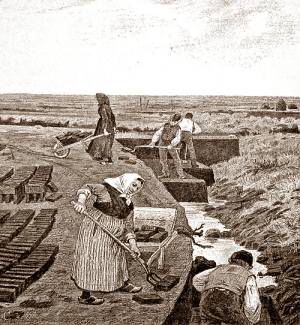 Well into the mid-20th century there were places where peat fires were kept alight all year
on the floor of a cottage. You can also burn turf, or sod, on open hearths, and in well-engineered
fireplaces with grates. Natural, locally-dug peat is still used for domestic heating in Scotland and, famously, in Ireland
where the slices of peat are always called turves and the fires are turf fires - even when manufactured peat briquettes are used.
In the 19th century cutting peat for fuel was an important part of life in Scandinavia,
and in fenland or moorland regions of England, the Netherlands, Belgium, and Germany.
Well into the mid-20th century there were places where peat fires were kept alight all year
on the floor of a cottage. You can also burn turf, or sod, on open hearths, and in well-engineered
fireplaces with grates. Natural, locally-dug peat is still used for domestic heating in Scotland and, famously, in Ireland
where the slices of peat are always called turves and the fires are turf fires - even when manufactured peat briquettes are used.
In the 19th century cutting peat for fuel was an important part of life in Scandinavia,
and in fenland or moorland regions of England, the Netherlands, Belgium, and Germany.
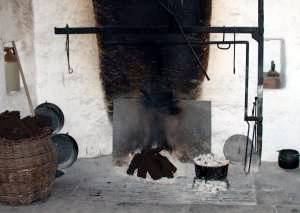 In Ireland, Scotland and parts of England it was considered very important to keep
the fire burning all the time. At bed-time a peat block and/or ashes would be arranged
to "smother" the fire without extinguishing it, so it would stay gently smouldering
overnight. Then in the morning it would be blown into life again. Because of the
significance laid on never letting the hearth go cold it's hard to find descriptions
of anyone lighting a domestic peat fire. There would surely have been varied local
customs for building the pile of turves, the use of kindling etc. - just as there
were different tools and customs for cutting peat. Peat quality varies too, depending on its depth, colour, age, and more.
In Ireland, Scotland and parts of England it was considered very important to keep
the fire burning all the time. At bed-time a peat block and/or ashes would be arranged
to "smother" the fire without extinguishing it, so it would stay gently smouldering
overnight. Then in the morning it would be blown into life again. Because of the
significance laid on never letting the hearth go cold it's hard to find descriptions
of anyone lighting a domestic peat fire. There would surely have been varied local
customs for building the pile of turves, the use of kindling etc. - just as there
were different tools and customs for cutting peat. Peat quality varies too, depending on its depth, colour, age, and more.
...on the hearth, the ashes, instead of being inconvenient, are extremely useful to poor people in various processes of their cookery. Hot peat ashes are excellent for roasting fish, eggs, etc.; and likewise for stewing, and any kind of cookery that requires a mild heat. In this respect it approaches to charcoal.
Webster and Parkes, An Encyclopædia of Domestic Economy, 1855
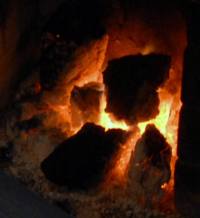 How do you cook over a fire in the middle of the floor? You can have a chain and
hook hanging from the roof above. In Scottish croft houses like the
blackhouse
in the photo (top right) this could hold a potful of porridge or broth, an iron
kettle boiling water, or a griddle for baking bannocks
or flat oat bread.
How do you cook over a fire in the middle of the floor? You can have a chain and
hook hanging from the roof above. In Scottish croft houses like the
blackhouse
in the photo (top right) this could hold a potful of porridge or broth, an iron
kettle boiling water, or a griddle for baking bannocks
or flat oat bread.
Even simpler is to just place a cooking pot on the pile of burning turves. If it's a cauldron with three little legs it will balance even better, but a well-made heap of peat, with ashes, can hold an iron pot quite steady - probably better than wood (or coal). Putting glowing turves on the lid adds all-round heat for a more "oven-like" style of cooking. You can even bake "turf cake" in a well-sealed pan or Dutch oven surrounded by hot peats and insulating ashes. This method was still in use in 1930s rural Scotland - probably in Ireland too. Potatoes were placed in embers and hot ash to bake in their skins, as an alternative to boiling them in a stew-pot. Peat is a very "ashy" fuel.
Baking was ‘down under’, in the fire’s heart using a ‘baking iron’ ....a flat circular piece of cast iron approximately 1⁄2in thick and 2ft diameter ...set on a bed of hot ashes. ... biscuits or yeast cake were placed...on the iron and covered by the baker, a flattened cast-iron dome. The join was sealed with ashes, more hot ‘coals’ and new turves were heaped over it, and the whole was left for an hour or so or until an ear placed to a poker reached in to touch the baker could hear the food ‘frizzin’...(Cornwall)
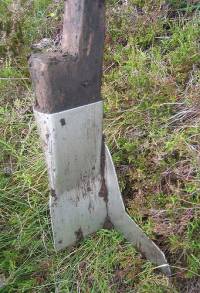 Peat smoke has a pungent "peat-reek", and the smell gives a special flavour to fish or meat hanging from
the ceiling or fireplace to be preserved by smoking. The distinctive aroma comes
through in some whiskies too.
Peat smoke has a pungent "peat-reek", and the smell gives a special flavour to fish or meat hanging from
the ceiling or fireplace to be preserved by smoking. The distinctive aroma comes
through in some whiskies too.
Cutting turves, digging peat, drying, carrying, stacking, storing
Getting peat ready for burning all year round in the home involves the same basic approach everywhere - and yet there are many varied styles of tool, and many different ways of organising the job. Will it be one person alone cutting off the top turves, digging the lower layers, and stacking? Or a team of men? Or men digging and women taking over the next stages? Families or communities working together, or a few professional peat-cutters planning to sell the peat?
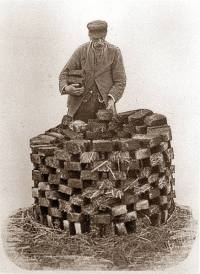 Start by removing the top few inches, then dig out some slices or bricks from the
darker layers
lower down. You may use a knife to get started. A sharp spade with a wing at right
angles (above right) helps make neatly-shaped peats. Someone has to lay them out
in a formation that allows them to dry in the air (photos left, below right, drawing
above left), and they'll probably stay there a week or two. They may be beaten or
trodden to make them more compact.
Start by removing the top few inches, then dig out some slices or bricks from the
darker layers
lower down. You may use a knife to get started. A sharp spade with a wing at right
angles (above right) helps make neatly-shaped peats. Someone has to lay them out
in a formation that allows them to dry in the air (photos left, below right, drawing
above left), and they'll probably stay there a week or two. They may be beaten or
trodden to make them more compact.
Next they have to go into storage that will last through the winter - maybe near your peat bank or strip, preferably near home. They may be carried in nets or baskets, on sledges, wheelbarrows, carts, or animals. They must be stacked so simple heaps will shed rainwater. Better still, the stack can be thatched, or sheltered in a farm building.
There is a lot of information on the web about traditional peat harvesting. For English-speakers it's mostly about Ireland and Scotland. Before links to further information and pictures, here's some extra vocabulary to help anyone googling for more detail.
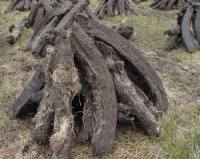 UK and Ireland regional names for turf or peat
spades (some for top layers, some for deeper digging): peat-iron, turfing-iron,
tusker, tushker, tarasgeir, slane, sleaghdn, flaughter, flachter, scraw-cutter,
bullin spade, breast spade
UK and Ireland regional names for turf or peat
spades (some for top layers, some for deeper digging): peat-iron, turfing-iron,
tusker, tushker, tarasgeir, slane, sleaghdn, flaughter, flachter, scraw-cutter,
bullin spade, breast spade
Peat carriers: kishies, meshies, creels, currachs
Places to dig: peat bank, peat hill, turbary, peatery, turf stead, trench, moss,
peat-delf
Stack: rick, dyke, daek, peat-bing
- The Turf Spade - EU Cultural Landscape Project
- Peat-cutter's equipment from Belgium
- Video of peat cutting
- Antique tools including several peat spades
- German peat-cutting
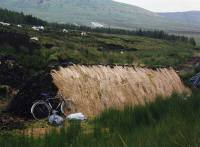 Other
pages on this site about fires, baking etc.:
Other
pages on this site about fires, baking etc.:
Baking on a griddle
Baker's peels
Community ovens
Fireplaces
 15 June 2009
15 June 2009
You may like our new sister site Home Things Past where you'll find articles about antiques, vintage kitchen stuff, crafts, and other things to do with home life in the past. There's space for comments and discussion too. Please do take a look and add your thoughts. (Comments don't appear instantly.)
For sources please refer to the books page, and/or the excerpts quoted on the pages of this website, and note that many links lead to museum sites. Feel free to ask if you're looking for a specific reference - feedback is always welcome anyway. Unfortunately, it's not possible to help you with queries about prices or valuation.


